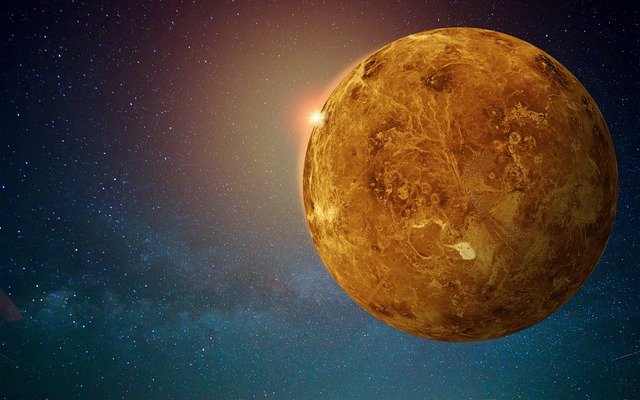By Tim Lambert
The Observation of Venus
Venus is named after the Roman goddess of love. It’s a bright object in the sky but even when the telescope was invented the surface was hidden by clouds. Nevertheless, Galileo discovered that Venus has phases like the Moon. Then in 1639, Jeremiah Horrocks became the first person to observe a transit of Venus (When Venus comes directly between the Earth and the Sun it is visible as a spot moving across the Sun’s disc).
Venus in Science Fiction
The surface of Venus is shrouded by clouds. People thought they were made of water vapor but they are sulfuric acid. In the past, the surface of Venus was a mystery. Some people imagined that though it would be hotter than Earth it supported life and humans could live there.
The first story about Venus was an anonymous work called The Great Romance published in 1881. It was followed in 1895 by a book called Journey to Venus by Gustavus Pope. Edgar Rice Burroughs wrote a series of adventure stories set on Venus.
In 1942 C S Lewis wrote a novel called Voyage to Venus. A man named Ransom is transported to Venus. He finds that most of the surface of Venus is covered in water and only small parts are dry land. The inhabitants are humanoids with green skin. In 1950 Ray Bradbury wrote a story called The Long Rain in which astronauts land on Venus and find it never stops raining.
Probes to Venus
Unfortunately, when automatic probes were sent to Venus in the late 20th century they destroyed the fantasy of an Earth-like planet. The first probe to reach Venus was Mariner 2, which was launched by the Americans in August 1962. In December 1962 it flew within 22,000 miles of Venus.
In 1967 Mariner 5 flew by Venus. Also in 1967, a Russian probe called Venera 4 launched a capsule into the atmosphere of Venus. It analyzed the atmosphere, finding it to be almost all carbon dioxide with tiny amounts of oxygen and water vapor. It also measured atmospheric pressure and measured the temperature before it stopped transmitting. (It was crushed by the atmospheric pressure). Russian probes Venera 5 and Venera 6 carried out further measurements of the atmosphere of Venus in 1969.
In 1970 Russian probe Venera 7 landed on Venus and transmitted data from the surface. Venera 8 landed on Venus in 1972. In 1974 Mariner 10 flew past Venus on its way to Mercury and took close-up images of the planet. In 1975 Venera 9 went to Venus. It was followed by Venera 10, which also reached Venus in 1975. Then in 1978 Venera 11 and Venera 12 reached Venus. Pioneer Venus 1 and Pioneer Venus 2 reached Venus in 1978.
Venera 13 and Venera 14 went to Venus in 1982. Then in 1983 Venera 15 and Venera 16 reached Venus. Vega 1 and Vega 2 reached Venus in 1985. Then in 1990 a probe named Magellan went into orbit around Venus and mapped the surface with radar. Another probe, Venus Express reached Venus in 2006.

At some point in the 21st century human beings will land on Venus although the environment is very inhospitable.
Last revised 2024